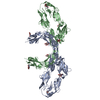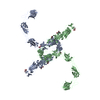+ Open data
Open data
- Basic information
Basic information
| Entry | Database: PDB / ID: 9ba4 | ||||||
|---|---|---|---|---|---|---|---|
| Title | Full-length cross-linked Contactin 2 (CNTN2) | ||||||
 Components Components | Contactin-2 | ||||||
 Keywords Keywords | MEMBRANE PROTEIN / contactins / adhesion molecule / protein structure / conformational changes / homodimer | ||||||
| Function / homology |  Function and homology information Function and homology informationestablishment of protein localization to juxtaparanode region of axon / presynaptic membrane organization / regulation of axon diameter / positive regulation of adenosine receptor signaling pathway / L1CAM interactions / regulation of astrocyte differentiation / reduction of food intake in response to dietary excess / clustering of voltage-gated potassium channels / cerebral cortex GABAergic interneuron migration / dendrite self-avoidance ...establishment of protein localization to juxtaparanode region of axon / presynaptic membrane organization / regulation of axon diameter / positive regulation of adenosine receptor signaling pathway / L1CAM interactions / regulation of astrocyte differentiation / reduction of food intake in response to dietary excess / clustering of voltage-gated potassium channels / cerebral cortex GABAergic interneuron migration / dendrite self-avoidance / protein localization to juxtaparanode region of axon / NrCAM interactions / central nervous system myelination / cell-cell adhesion mediator activity / positive regulation of protein processing / G protein-coupled adenosine receptor signaling pathway / axon initial segment / NCAM1 interactions / juxtaparanode region of axon / node of Ranvier / axonal fasciculation / regulation of cell morphogenesis / adult walking behavior / negative regulation of neuron differentiation / fat cell differentiation / homophilic cell-cell adhesion / regulation of neuronal synaptic plasticity / side of membrane / axon guidance / learning / establishment of localization in cell / synapse organization / protein processing / receptor internalization / microtubule cytoskeleton organization / myelin sheath / carbohydrate binding / postsynaptic membrane / cell adhesion / axon / neuronal cell body / synapse / cell surface / plasma membrane Similarity search - Function | ||||||
| Biological species |  Homo sapiens (human) Homo sapiens (human) | ||||||
| Method | ELECTRON MICROSCOPY / single particle reconstruction / cryo EM / Resolution: 3.54 Å | ||||||
 Authors Authors | Liu, J.L. / Fan, S.F. / Ren, G.R. / Rudenko, G.R. | ||||||
| Funding support |  United States, 1items United States, 1items
| ||||||
 Citation Citation |  Journal: Structure / Year: 2024 Journal: Structure / Year: 2024Title: Molecular mechanism of contactin 2 homophilic interaction. Authors: Shanghua Fan / Jianfang Liu / Nicolas Chofflet / Aaron O Bailey / William K Russell / Ziqi Zhang / Hideto Takahashi / Gang Ren / Gabby Rudenko /   Abstract: Contactin 2 (CNTN2) is a cell adhesion molecule involved in axon guidance, neuronal migration, and fasciculation. The ectodomains of CNTN1-CNTN6 are composed of six Ig domains (Ig1-Ig6) and four FN ...Contactin 2 (CNTN2) is a cell adhesion molecule involved in axon guidance, neuronal migration, and fasciculation. The ectodomains of CNTN1-CNTN6 are composed of six Ig domains (Ig1-Ig6) and four FN domains. Here, we show that CNTN2 forms transient homophilic interactions (K ∼200 nM). Cryo-EM structures of full-length CNTN2 and CNTN2_Ig1-Ig6 reveal a T-shaped homodimer formed by intertwined, parallel monomers. Unexpectedly, the horseshoe-shaped Ig1-Ig4 headpieces extend their Ig2-Ig3 tips outwards on either side of the homodimer, while Ig4, Ig5, Ig6, and the FN domains form a central stalk. Cross-linking mass spectrometry and cell-based binding assays confirm the 3D assembly of the CNTN2 homodimer. The interface mediating homodimer formation differs between CNTNs, as do the homophilic versus heterophilic interaction mechanisms. The CNTN family thus encodes a versatile molecular platform that supports a very diverse portfolio of protein interactions and that can be leveraged to strategically guide neural circuit development. | ||||||
| History |
|
- Structure visualization
Structure visualization
| Structure viewer | Molecule:  Molmil Molmil Jmol/JSmol Jmol/JSmol |
|---|
- Downloads & links
Downloads & links
- Download
Download
| PDBx/mmCIF format |  9ba4.cif.gz 9ba4.cif.gz | 361.4 KB | Display |  PDBx/mmCIF format PDBx/mmCIF format |
|---|---|---|---|---|
| PDB format |  pdb9ba4.ent.gz pdb9ba4.ent.gz | 280.4 KB | Display |  PDB format PDB format |
| PDBx/mmJSON format |  9ba4.json.gz 9ba4.json.gz | Tree view |  PDBx/mmJSON format PDBx/mmJSON format | |
| Others |  Other downloads Other downloads |
-Validation report
| Summary document |  9ba4_validation.pdf.gz 9ba4_validation.pdf.gz | 1.6 MB | Display |  wwPDB validaton report wwPDB validaton report |
|---|---|---|---|---|
| Full document |  9ba4_full_validation.pdf.gz 9ba4_full_validation.pdf.gz | 1.6 MB | Display | |
| Data in XML |  9ba4_validation.xml.gz 9ba4_validation.xml.gz | 64.2 KB | Display | |
| Data in CIF |  9ba4_validation.cif.gz 9ba4_validation.cif.gz | 97 KB | Display | |
| Arichive directory |  https://data.pdbj.org/pub/pdb/validation_reports/ba/9ba4 https://data.pdbj.org/pub/pdb/validation_reports/ba/9ba4 ftp://data.pdbj.org/pub/pdb/validation_reports/ba/9ba4 ftp://data.pdbj.org/pub/pdb/validation_reports/ba/9ba4 | HTTPS FTP |
-Related structure data
| Related structure data |  44395MC  9ba5C M: map data used to model this data C: citing same article ( |
|---|---|
| Similar structure data | Similarity search - Function & homology  F&H Search F&H Search |
- Links
Links
- Assembly
Assembly
| Deposited unit | 
|
|---|---|
| 1 |
|
- Components
Components
| #1: Protein | Mass: 108697.281 Da / Num. of mol.: 2 Source method: isolated from a genetically manipulated source Source: (gene. exp.)  Homo sapiens (human) / Gene: CNTN2, AXT, TAG1, TAX1 / Cell (production host): HighFive5 / Production host: Homo sapiens (human) / Gene: CNTN2, AXT, TAG1, TAX1 / Cell (production host): HighFive5 / Production host:  Trichoplusia ni (cabbage looper) / References: UniProt: Q02246 Trichoplusia ni (cabbage looper) / References: UniProt: Q02246#2: Polysaccharide | 2-acetamido-2-deoxy-beta-D-glucopyranose-(1-4)-2-acetamido-2-deoxy-beta-D-glucopyranose #3: Sugar | ChemComp-NAG / Has ligand of interest | Y | Has protein modification | Y | |
|---|
-Experimental details
-Experiment
| Experiment | Method: ELECTRON MICROSCOPY |
|---|---|
| EM experiment | Aggregation state: PARTICLE / 3D reconstruction method: single particle reconstruction |
- Sample preparation
Sample preparation
| Component | Name: Contactin-2 full length (Ig1-FN4) / Type: ORGANELLE OR CELLULAR COMPONENT / Entity ID: #1 / Source: RECOMBINANT | |||||||||||||||
|---|---|---|---|---|---|---|---|---|---|---|---|---|---|---|---|---|
| Source (natural) | Organism:  Homo sapiens (human) Homo sapiens (human) | |||||||||||||||
| Source (recombinant) | Organism:  Trichoplusia ni (cabbage looper) Trichoplusia ni (cabbage looper) | |||||||||||||||
| Buffer solution | pH: 8 / Details: 10 mM HEPES pH 8.0, 50 mM NaCl | |||||||||||||||
| Buffer component |
| |||||||||||||||
| Specimen | Conc.: 0.05 mg/ml / Embedding applied: NO / Shadowing applied: NO / Staining applied: NO / Vitrification applied: YES | |||||||||||||||
| Vitrification | Instrument: LEICA EM GP / Cryogen name: ETHANE / Humidity: 90 % / Chamber temperature: 281 K |
- Electron microscopy imaging
Electron microscopy imaging
| Experimental equipment |  Model: Titan Krios / Image courtesy: FEI Company |
|---|---|
| Microscopy | Model: TFS KRIOS |
| Electron gun | Electron source:  FIELD EMISSION GUN / Accelerating voltage: 300 kV / Illumination mode: FLOOD BEAM FIELD EMISSION GUN / Accelerating voltage: 300 kV / Illumination mode: FLOOD BEAM |
| Electron lens | Mode: BRIGHT FIELD / Nominal magnification: 81000 X / Nominal defocus max: 1600 nm / Nominal defocus min: 600 nm |
| Specimen holder | Specimen holder model: FEI TITAN KRIOS AUTOGRID HOLDER |
| Image recording | Average exposure time: 7.39 sec. / Electron dose: 50 e/Å2 / Film or detector model: GATAN K3 (6k x 4k) / Num. of grids imaged: 1 / Num. of real images: 9049 |
| EM imaging optics | Energyfilter name: GIF Bioquantum / Energyfilter slit width: 20 eV |
- Processing
Processing
| EM software |
| ||||||||||||||||||||||||||||||||||||
|---|---|---|---|---|---|---|---|---|---|---|---|---|---|---|---|---|---|---|---|---|---|---|---|---|---|---|---|---|---|---|---|---|---|---|---|---|---|
| CTF correction | Type: PHASE FLIPPING AND AMPLITUDE CORRECTION | ||||||||||||||||||||||||||||||||||||
| 3D reconstruction | Resolution: 3.54 Å / Resolution method: FSC 0.143 CUT-OFF / Num. of particles: 86023 / Symmetry type: POINT | ||||||||||||||||||||||||||||||||||||
| Atomic model building | Protocol: FLEXIBLE FIT | ||||||||||||||||||||||||||||||||||||
| Refinement | Cross valid method: NONE Stereochemistry target values: GeoStd + Monomer Library + CDL v1.2 | ||||||||||||||||||||||||||||||||||||
| Displacement parameters | Biso mean: 190.7 Å2 | ||||||||||||||||||||||||||||||||||||
| Refine LS restraints |
|
 Movie
Movie Controller
Controller





 PDBj
PDBj








